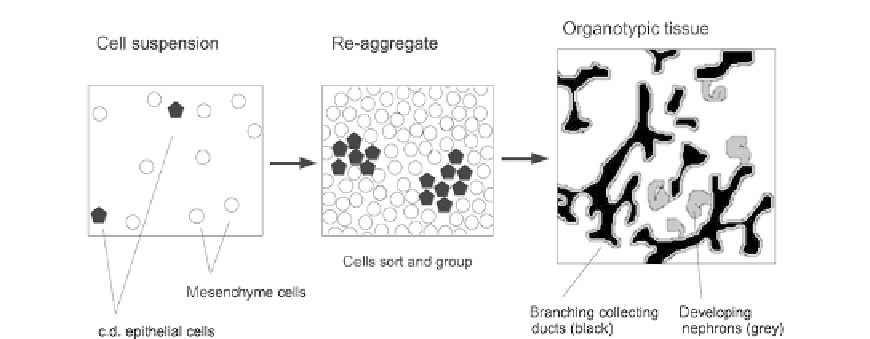Biology Reference
In-Depth Information
FIGURE 27.3
Cells from mouse renal rudiments, which have been reduced to a suspension with no neighbour
relations, will spontaneously reorganize themselves into a new organ rudiment that shows features typical of
normal renal development.
This exact experiment has been done with embryonic kidneys.
9
At the stage that the
organs were disassembled, they consisted of a once-branched epithelial tube (the future
urine-collecting duct system) surrounded by mesenchyme cells that would, in normal devel-
opment, be a source of both epithelial nephrons and stroma. After disassembly of five organ
rudiments into single cells and their re-aggregation, with some drug support to block death
from anoikis (Chapter 24), the cells were initially arranged as a random mix. They sorted out
so that the collecting duct cells formed small groups, and each of these then founded a collect-
ing duct tree; the tree induced nephrons to form beside it and to connect to it, just as happens
in normal development (
Figure 27.3
). Although the formation of multiple trees (tens) instead
of just one would not be normal, it helps to underline the point that cells were not simply
returning to remembered positions, but were rather organizing themselves all over again
according to their new environment. An engineered kidney rudiment based correctly on
one collecting duct tree can be made by isolating one of the trees made in the system
described above and combining it with a suspension of fresh mesenchyme cells;
10
kidneys
made this way show physiological function when grafted into hosts.
11
SYNTHETIC MORPHOLOGY
'Synthetic morphology', a term that was first used in a 2008 paper
12
that discussed the
potential power of the approach, is a sub-field of synthetic biology. It aims to achieve
designed morphogenetic behaviour through construction of a morphogenetic mechanism
in cells that do not already have it. The relevance of the technique to basic research, rather
than to practical tissue engineering, is that it provides a robust test of our theories of
development. In the words of the physicist Richard Feynman: '
What I cannot create, I do not
understand
'.
13
An early application of the synthetic approach has been the series of experiments designed
to test the hypothesis that differential adhesion can drive cell sorting and relative positioning



